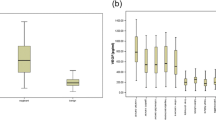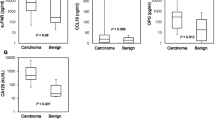Abstract
Background and Aims
Ascites with unknown cause remains a diagnostic challenge, which needs novel noninvasive biomarkers for the precise diagnosis. We aimed to evaluate the ascitic fluid and serum C-reactive protein (CRP) and vascular endothelial growth factor (VEGF) as diagnostic markers in the differential diagnosis of malignant and benign ascites.
Methods
In this prospective work, 315 consecutive patients with ascites were studied. Ascitic fluid and serum levels of CRP and VEGF were evaluated by using an enzyme-linked immunosorbent assay.
Results
Patients were divided into a benign ascites group (group 1) (n = 256) and a malignant ascites group (group 2) (n = 59). Ascitic and serum CRP were significantly elevated in malignant ascites than benign ascites group [5.08 (3.62–6.58) vs. 1.82 (0.64–3.86) ng/ml; P < 0.001 and 12.7 (8.55–17.05) vs. 5.94 (2.57–10.64) ng/ml; P < 0.001], respectively. Ascitic and serum VEGF were significantly increased in malignant ascites than benign ascites patients [0.68 (0.39–0.96) vs. 0.41 (0.25–0.83) ng/ml; P < 0.001 and 0.74 (0.41–1.08) vs. 0.54 (0.23–0.86) ng/ml; P < 0.001], respectively. At a cutoff value of 7.3 and 0.63 ng/ml, serum CRP and VEGF had specificity (77.3 and 89.5 %) and sensitivity (83.1 and 94.9 %) for detecting malignant ascites [area under the curve (AUC) 0.821, 0.921], respectively. At a cutoff value of 2.5 and 0.57 ng/ml, ascitic CRP and VEGF had specificity (81.6 and 85.5 %) and sensitivity (84.7 and 91.5 %) for detecting malignant ascites (AUC 0.842, 0.894), respectively.
Conclusion
Elevated ascitic fluid and serum CRP and VEGF values were related to the malignant ascites.

Similar content being viewed by others
Abbreviations
- CRP:
-
C-reactive protein
- VEGF:
-
Vascular endothelial growth factor
- AFI:
-
Ascitic fluid infections
- SBP:
-
Spontaneous bacterial peritonitis
References
Runyon BA. Ascites. In: Schiff L, Schiff ER, editors. Diseases of the liver. Philadelphia: Lippincott Company; 1993. p. 990–1015.
Parsons SL, Watson SA, Steele RJC. Malignant ascites. Br J Surg. 1996;83(1):6–14.
Yabushita H, Shimazu M, Noguchi M, et al. Vascular endothelial growth factor activating matrix metalloproteinase in ascitic fluid during peritoneal dissemination of ovarian cancer. Oncol Rep. 2003;10(1):89–95.
Summah H, Qu JM. Biomarkers: a definite plus in pneumonia. Mediat Inflamm. 2009;2009(675753):1–9.
Yuksel I, Karaahmet F, Coskun Y, et al. Significance of serum and ascitic fluid C-reactive protein in the differential diagnosis of benign and malignant ascites. Dig Dis Sci. 2014;59(10):2588–93.
Runyon BA, AASLD. Introduction to the revised American Association for the Study of Liver Diseases practice guideline management of adult patients with ascites due to cirrhosis 2012. Hepatology. 2013;57:1651–3.
Abdel-Razik A, Eldars W, Rizk E. Platelet indices and inflammatory markers as diagnostic predictors for ascitic fluid infection. Eur J Gastroenterol Hepatol. 2014;26:1342–7.
Moore KP, Aithal GP. Guidelines on the management of ascites in cirrhosis. Gut. 2006;55(6):vi1–vi12.
Levey AS, Bosch JP, Lewis JB, et al. A more accurate method to estimate glomerular filtration rate from serum creatinine: a new prediction equation. Modification of Diet in Renal Disease Study Group Ann Intern Med. 1999;130:461–70.
Czaja AJ, Freese DK. American Association for the Study of liver disease. Diagnosis and treatment of autoimmune hepatitis Hepatology. 2002;36:479–97.
Caldwell SH, Oelsner DH, Iezzoni JC. Cryptogenic cirrhosis: clinical characterization and risk factors for underlying disease. Hepatology. 1999;3:664–9.
Nagy JA, Herzberg KT, Dvorak JM, et al. Pathogenesis of malignant ascites formation: initiating events that lead to fluid accumulation. Cancer Res. 1993;53:2631–43.
Tangkijvanich P, Tresukosol D, Sampatanukul P, et al. Telomerase assay for differentiating between malignancy-related and nonmalignant ascites. Clin Cancer Res. 1999;5:2470–5.
Cekin Y, Cekin AH, Duman A, et al. The role of serum procalcitonin levels in predicting ascitic fluid infection in hospitalized cirrhotic and non-cirrhotic patients. Int J Med Sci. 2013;10:1367–74.
Light RW, Macgregor MI, Luchsinger PC, et al. Pleural effusions: the diagnostic separation of transudates and exudates. Ann Intern Med. 1972;77:508–13.
Garrison RN, Vaclin LD, Galloway RH, et al. Malignant ascites. Clinical and experimental observations. Ann Surg. 1986;203(6):644–51.
Loewenstein MS, Rittgers RA, Feinerman AE, et al. Carcinoembryonic antigen assay of ascites and detection of malignancy. Ann Intern Med. 1978;88(5):635–8.
Gerbes AL, Jungst D. Role of cholesterol determination in ascitic fluid analysis. Hepatology. 2009;50(4):1320.
Zweig MH, Campbell G. Receiver-operating characteristic (ROC) plots: a fundamental evaluation tool in clinical medicine. Clin Chem. 1993;39(4):561–77.
Swets JA. Measuring the accuracy of diagnostic systems. Science. 1988;240(4857):1285–93.
Aslam N, Marino CR. Malignant ascites: new concepts in pathophysiology, diagnosis, and management. Arch Intern Med. 2001;161(22):2733–7.
Abdel-Razik A, Eldars W, Elhelaly R, et al. C-reactive protein and insulin-like growth factor-1 in differential diagnosis of ascites. J Gastroenterol Hepatol. 2016. doi:10.1111/jgh.13386.
Bamias A, Koutsoukou V, Terpos E, et al. Correlation of NK T-like CD3 + CD56+ cells and CD4 + CD25 + (hi) regulatory T cells with VEGF and TNFalpha in ascites from advanced ovarian cancer: association with platinum resistance and prognosis in patients receiving firstline, platinum-based chemotherapy. Gynecol Oncol. 2008;108:421–7.
Yoshiji H, Kuriyama S, Hicklin DJ, et al. The vascular endothelial growth factor receptor KDR/Flk-1 is a major regulator of malignant ascites formation in the mouse hepatocellular carcinoma model. Hepatology. 2001;33:841–7.
Geva E, Jaffe RB. Role of vascular endothelial growth factor in ovarian physiology and pathology. Fertil Steril. 2000;74(3):429–43.
Nascimento I, Schaer R, Lemaire D, et al. Vascular endothelial growth factor (VEGF) levels as a tool to discriminate between malignant and nonmalignant ascites. APMIS. 2004;112:585–7.
Dong WG, Sun XM, Yu BP, et al. Role of VEGF and CD44v6 in differentiating benign from malignant ascites. World J Gastroenterol. 2003;9:2596–600.
Lee HK, Chae HS, Kim JS, et al. Vascular endothelial growth factor levels in ascites between chemonaive and chemotreated patients. Yonsei Med J. 2008;49:429–35.
Yoneda J, Kuniyasu H, Crispens MA, et al. Expression of angiogenesis-related genes and progression of human ovarian carcinomas in nude mice. J Natl Cancer Inst. 1998;90(6):447–54.
Bamberger ES, Perrett CW. Angiogenesis in epithelian ovarian cancer. Mol Pathol. 2002;55(6):348–59.
Zhan N, Dong WG, Wang J. The clinical significance of vascular endothelial growth factor in malignant ascites. Tumour Biol. 2016;37(3):3719–25.
Hirschfield GM, Pepys M. C-reactive protein and cardiovascular disease: new insights from an old molecule. Q J Med. 2003;96:793–807.
Mendall MA, Strachan D, Butland BK, et al. C-reactive protein: relation to total mortality, cardiovascular mortality and cardiovascular risk factors in men. Eur Heart J. 2000;21:1584–90.
Bota DP, van Nuffelen M, Zakariah AH, et al. Serum level of C-reactive protein and procalcitonin in critically ill patients with cirrhosis of the liver. J Lab Clin Med. 2005;146:347–51.
Imhof A, Froehlich M, Boeing H, et al. Effect of alcohol consumption on systemic markers of inflammation. Lancet. 2001;357:763–7.
Heikkila¨ K, Ebrahim S, Lawlor DA. A systematic review of the association between circulating concentrations of C-reactive protein and cancer. J Epidemiol Community Health. 2007;61:824–33.
Jabs WJ, Busse M, Kruger S, et al. Expression of C-reactive protein by renal cell carcinomas and unaffected surrounding renal tissue. Kidney Int. 2005;68:2103–10.
Blann AD, Byrne GJ, Baildam AD. Increased soluble intercellular adhesion molecule-1, breast cancer, and the acute phase response. Blood Coagul Fibrinolysis. 2002;13:165–8.
Wang CS, Sun CF. C-reactive protein and malignancy: clinicopathological association and therapeutic implication. Chang Gung Med J. 2009;32:471–82.
Author information
Authors and Affiliations
Corresponding author
Ethics declarations
Conflict of Interest
We have no conflicts of interest to disclose.
Financial Support
None.
Rights and permissions
About this article
Cite this article
Abdel-Razik, A., Mousa, N., Elalfy, H. et al. A Novel Combination of C-Reactive Protein and Vascular Endothelial Growth Factor in Differential Diagnosis of Ascites. J Gastrointest Canc 48, 50–57 (2017). https://doi.org/10.1007/s12029-016-9873-x
Published:
Issue Date:
DOI: https://doi.org/10.1007/s12029-016-9873-x




